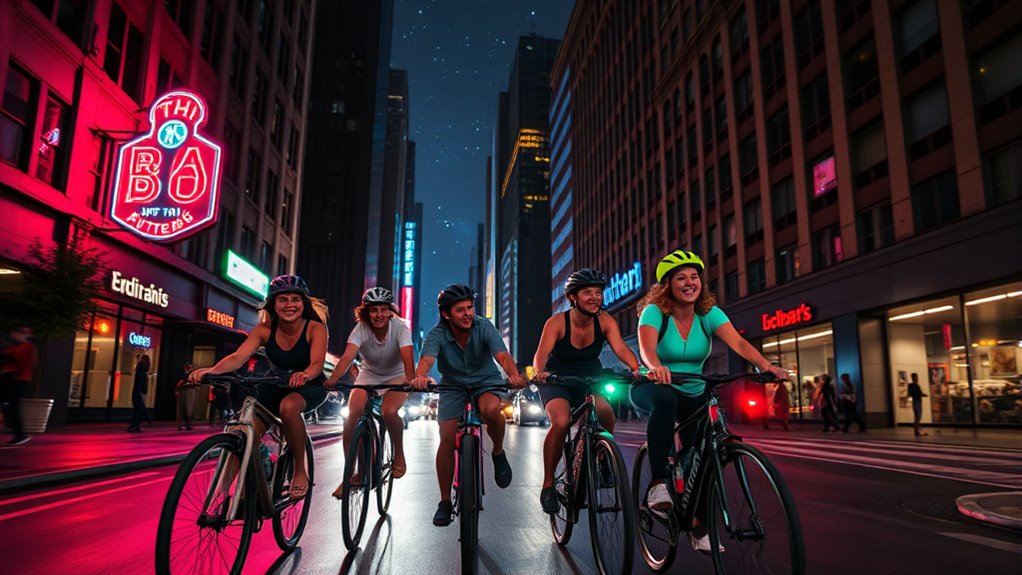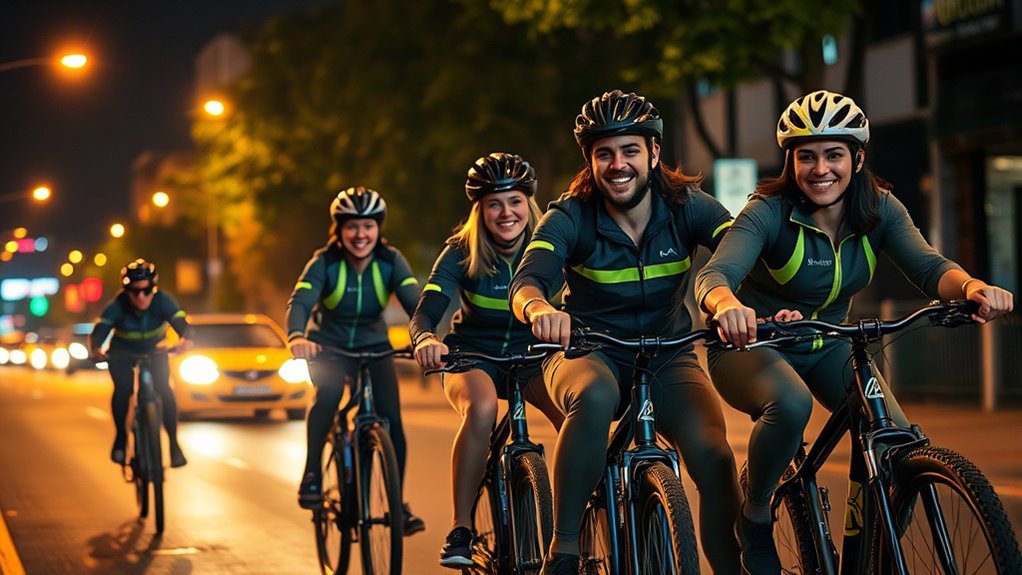When riding with friends at night, prioritize safety by checking all lights and signals before you start, and carry extra flashlights or headlamps for emergencies. Use your lights strategically to communicate intentions, maintain a safe distance, and follow a planned route with clear signals. Creating a fun, memorable vibe depends on organization and camaraderie, but staying aware of safety tips guarantees everyone enjoys the experience without risks. Keep exploring to discover how to make your night rides even better.
Key Takeaways
- Ensure all vehicle lights are functioning properly and carry extra flashlights for emergencies.
- Establish a route, signals, and communication methods before starting the ride.
- Maintain safe distances and use lights to communicate intentions clearly.
- Assign roles like lead and tail rider to keep the group organized and safe.
- Enjoy the unique atmosphere and camaraderie, prioritizing safety throughout the experience.

There’s something exhilarating about hitting the road with friends after sunset, feeling the cool night air and hearing the hum of engines as you explore familiar streets or venture into new territory. Night rides create a unique vibe — the city lights flickering, the quiet of late hours, and the sense of camaraderie that grows as you share the experience. But to truly enjoy these moments, safety has to be your top priority, especially when it comes to lighting safety and group coordination.
Lighting safety is essential during night rides. You want your vehicle’s lights to be clear and functioning properly, so you can see and be seen. Before heading out, double-check that all headlights, tail lights, and turn signals are working. It’s also wise to carry an extra flashlight or headlamp in case of emergencies or breakdowns. Proper lighting isn’t just about seeing; it’s about ensuring others can see you clearly, reducing the risk of accidents. When riding in a group, maintain consistent spacing, so no one’s tail lights are obscured or too far away to be noticed. Use your lights strategically—brake lights when stopping, and turn signals when changing direction—to communicate clearly with your friends and other drivers.
Group coordination becomes even more vital at night. Establish a plan beforehand: agree on a route, set a pace, and decide on signals for stopping or regrouping. Communication is your best tool here. Use hand signals or a designated voice system, like a Bluetooth headset, to stay in touch without distractions. Keep an eye on your group, ensuring no one falls behind or gets separated. If someone needs to stop for a break or a quick fix, make it a point to pull over safely and wait for everyone to catch up. This prevents confusion and keeps the ride organized. It’s also a good idea to assign a lead rider who navigates and a tail rider who keeps track of the group. This way, you minimize the chances of someone getting lost or making wrong turns.
Frequently Asked Questions
What Should I Bring for Emergency Situations During Night Rides?
For emergency situations during night rides, you should bring a compact first aid kit and reflective gear. The first aid kit helps you handle cuts, scrapes, or minor injuries quickly, while reflective gear keeps you visible to others, especially in low light. Always check your supplies before heading out, and consider carrying a charged phone for emergencies. Staying prepared guarantees you can enjoy your ride safely and confidently.
How Can I Ensure Everyone Stays Alert and Safe Throughout the Ride?
Like a team in a well-orchestrated mission, you keep everyone alert by maintaining constant group communication and clear ride planning. Use walkie-talkies or messaging apps to check in regularly, remind everyone of safety tips, and watch for signs of fatigue. Encourage breaks and stay aware of each rider’s condition. Staying connected, planning ahead, and fostering open dialogue will guarantee everyone has a safe, enjoyable ride—no time machine needed.
Are There Specific Routes Safest for Night Rides With Friends?
You should choose scenic routes with well-lit, familiar roads to enhance safety during night rides with friends. Highlight scenic routes that offer clear visibility and minimal hazards, making the ride enjoyable and secure. Additionally, plan rest stops along the way to keep everyone alert and refreshed. Avoid unfamiliar or poorly lit areas, and always keep your phone or GPS handy to stay on safe paths.
What Gear or Equipment Enhances Safety During Night Rides?
You can enhance safety during night rides by wearing reflective gear that makes you more visible to others. Equip your bike with lighting accessories like front and rear lights to illuminate your path and alert drivers of your presence. Consider adding reflective tape to your helmet or clothing for extra visibility. These tools help you stay safe and enjoy your ride confidently, no matter how dark it gets.
How Do I Handle Conflicts or Disagreements During the Ride?
Imagine your group as a steady river, flowing smoothly. When conflicts arise, you handle them with open communication, like clear waters revealing hidden rocks. Use conflict resolution techniques—listen actively, stay calm, and speak kindly—to keep the flow steady. Address disagreements promptly, ensuring everyone feels heard. By fostering group communication, you maintain harmony, turning potential rapids into peaceful currents, so your night ride remains safe and enjoyable for all.
Conclusion
As you and your friends hit the road under the moon’s glow, remember that safety keeps the good vibes alive. Stay alert, stick together, and enjoy every moment—because just around the next bend, something unexpected could happen. Are you ready for the thrill of the night, or will you let caution fade into the shadows? One thing’s certain: tonight’s ride isn’t over yet, and the best surprises are still waiting just beyond your sight.









